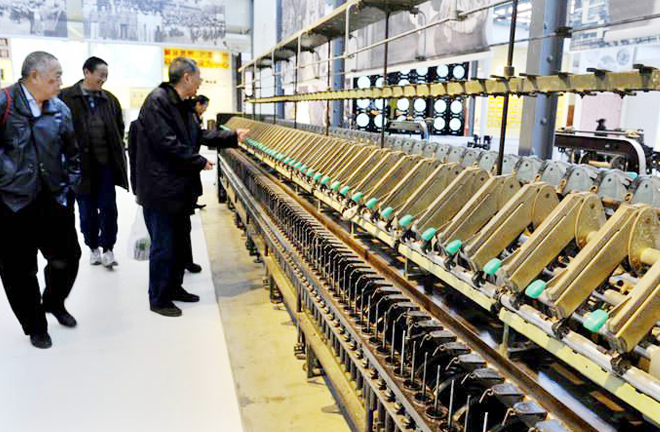Better protecting industrial heritage in China

Visitors observe textile machines at the Dahua Industrial Relics Museum in Xi’an, Shaanxi Province. The museum belongs to the Dahua 1935 Project at the Dahua Textile Mill established in 1935, inheriting the precious relics of modern industrial civilization and integrating functions of modern urban society.
Rapid economic, social and infrastructure development in recent years has put the spotlight on how to best deal with urban planning and industrial heritage. Many industrial relics are rich in history and worthy of global attention, yet their protection and modern use are often neglected.
Industrial heritage protection first emerged in the UK. Xu Subin, a professor from the School of Architecture at Tianjin University, said that Western countries have successively set up organizations devoted to industrial heritage since the 1960s, engaging in research and protection efforts. In 2003, the International Committee for the Conservation of Industrial Heritage released the Nizhny Tagil Charter for Industrial Heritage.
Industrial heritage protection has also attracted attention in China. “Currently, China is undergoing rapid urbanization and upgrading its industrial structure. Nearly all cities face the issue of industrial heritage protection,” said Xu.
Que Weimin, a professor from the College of Urban and Environmental Sciences at Peking University, said that a large number of industrial relics have gradually disappeared amid rapid urbanization. How to identify, protect and utilize these relics before they fade into obscurity has therefore become an important issue for researchers, said Que.
In fact, China has already made fruitful accomplishments in industrial heritage protection. Que noted that several proposals have been made since 2006 related to industrial heritage protection, signaling a new stage in its management and research.
Some scholars claimed that the protection, inheritance and utilization of industrial heritage is a systematic project, posing a challenge to the coordination of all work.
Shan Jixiang, director of the Palace Museum, said that research of industrial heritage should be based on general investigation.
From 2007 to 2011, China carried out its third national survey of cultural relics. Industrial relics were regarded as significant research subjects. However, Xu said current survey efforts are insufficient. “Industrial heritage has yet to be put at the core of the surveys,” said Xu. Zhang Song, a professor from the College of Architecture and Urban Planning at Tongji University in Shanghai, said that it is necessary to utilize industrial relics rather than letting them languish.
“The Ruhr Industrial Base in Germany is a typical successful example, converted from an industrial relic to a modern industrial park,” said Zhang.
Regarding industrial heritage studies, Zhang said that current efforts pay too much attention to case studies and neglect theoretical research.
“In the long term, people are inclined to protect cultural relics with a long history and neglect modern industrial heritage,” said Zhang.
Xu said deeper public understanding of industrial heritage protection is needed. “Currently, people’s understanding of the value of industrial heritage is not keeping up with the pace of urban development,” said Xu.
In addition, Xu also claimed that society has a responsibility to engage in protection, inheritance and utilization of industrial relics. “Researchers should strengthen studies of the history of industrial technology, providing fundamental support for protection efforts. Enterprises should protect corporate culture and spirits and assume their responsibilities in protecting industrial heritage,” added Xu.
At the national level, Que said that it is necessary to set up a strategic plan that includes a management system for China’s industrial heritage, a detailed protection plan as well as national and provincial lists of industrial heritage.
In addition, he stressed that more attention should be paid to the protection of ancient agricultural relics and modern industrial relics. “Both kinds form significant components of the history of Chinese civilization,” said Que.
Some scholars claimed that it is necessary to combine social and economic efforts in the protection, utilization and management of industrial heritage, advocating a development path that better balances industrial heritage protection and urban construction.
